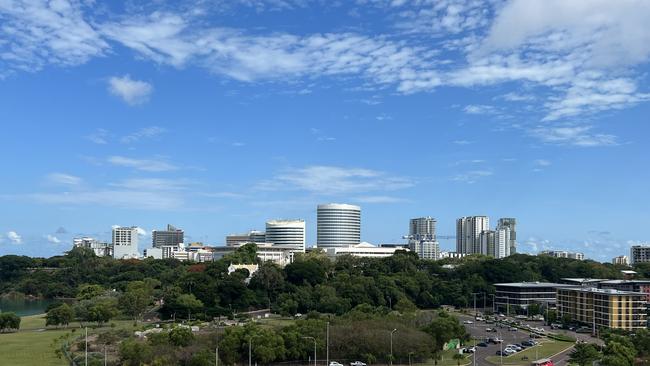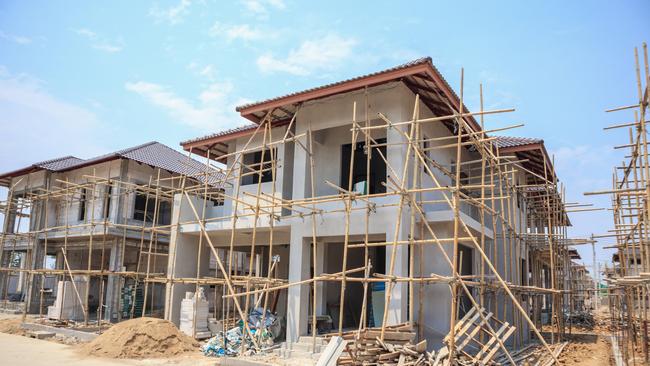Bringing down house prices key to lure entrepreneurs to NT according PropTrack senior economist
Paul Ryan is the man with the crystal ball for the country’s biggest real estate network, and he believes the solution to the NT’s housing woes lies right under our noses.

News
Don't miss out on the headlines from News. Followed categories will be added to My News.
Why would any one come to Darwin?
Answer that question and you answer the problem of housing affordability, according to realestate.com.au’s senior economist.
Before stepping into the role, Paul Ryan spent 10 years at the Reserve Bank of Australia tracking the relationship between property markets and household spending.
Speaking to the NT News about the future of the Territory housing market, Mr Ryan said the rapid construction of new apartments and units in Darwin over the last fifteen years was largely driven by mining booms.
It saw median unit prices fall to a five-year low of $280k in 2020 before climbing up to $400k this year.
That is still lower than the national average of $660k but the rise is being driven by the same economic factors: crippling building costs, skill shortages and low vacancy rates.

Housing prices tip of the iceberg
“It’s been particularly tough (for homebuyers) because there’s been such a big shift in cost of living over the past few years,” Mr Ryan said.
“If we go before the pandemic, we have a situation where low-income households could afford about a quarter of homes sold and median-income households could afford more than 50 per cent, but that’s obviously deteriorated quite markedly with interest rates.
“In the long term, it’s about lowering inflation and building more homes to put downward pressure on rents and prices.”
The Territory’s stagnant population growth may be discouraging large-scale development, according to Mr Ryan, with many workers flying in for large industry projects but failing to settle long-term.
Among all the states and territories, the NT ranks second from the bottom in population growth at 0.3 per cent population last financial year, well below the national average of 2.5 per cent.

Smaller houses, focus on ‘lifestyle’
Mr Ryan said that building more housing and the resulting drop in prices could draw entrepreneurial spirits to the Territory, as has happened in Adelaide with younger people looking to enter the market.
“Cheaper housing has broader effects, and one of the biggest is that people can take more risks with starting businesses,” Mr Ryan said.
“One of the growing concerns in Melbourne and Sydney is that if you have a huge mortgage, who would take that risk of leaving their office job when they have to worry about paying off a bigger mortgage over a longer period of time?
“That’s one of the unique advantages Darwin has – cheaper cost of living, lots of opportunities in defence and mining, and building that dynamism and opportunity is really important to the vibrancy of the economy.
“If you look at the data, a huge proportion of jobs are created by new businesses … and there has to be the idea that the market is growing to provide fertile ground for them.”
As for the question of what new builds will look like, developers will likely be betting on smaller dwellings and density housing.
“The pandemic has created this dichotomy where people are demanding space, but at the same time at the national level there has been increased demand for smaller dwellings, and I think affordability is a big part of that,” Ryan said.
“In the long-term, if we think about a growing Australia over the next two decades, how we’re going to house people and their preferences, part of that will depend on the demographic structure which will be increasingly ageing.
“These smaller-type dwellings will suit that demographic structure better but it will have to match with people’s willingness and comfort to adjust to changing dwelling structures.”

Flipping the switch
Asked about the Country Liberal Party’s promise of $50k first homebuilder grants should it take government, Mr Ryan said he believed it would push new housing outward rather than growing the city, requiring corresponding infrastructure growth.
“Without casting judgement, that’s a choice, and if their needs to be more urban infield development, this policy is not going to inspire that,” he said.
“But that’s a choice for the government in terms of what the urban structure of Darwin look like, and the more you push out, the more you have to service further and further out of field.”
Ultimately, the pathway to more housing involved land releases and looking at which gaps need to be filled in skilled trades.
“That’s not helpful in terms of how people are going to pay their bills over the next year or two unfortunately, but that’s just the difficult reality of housing – it takes a long time to build and respond to market forces.”
In early May, the Property Council issued similar recommendations, warning that the Territory will need 12,500 new homes by the decade’s end to meet population growth trends.
More Coverage
Originally published as Bringing down house prices key to lure entrepreneurs to NT according PropTrack senior economist




